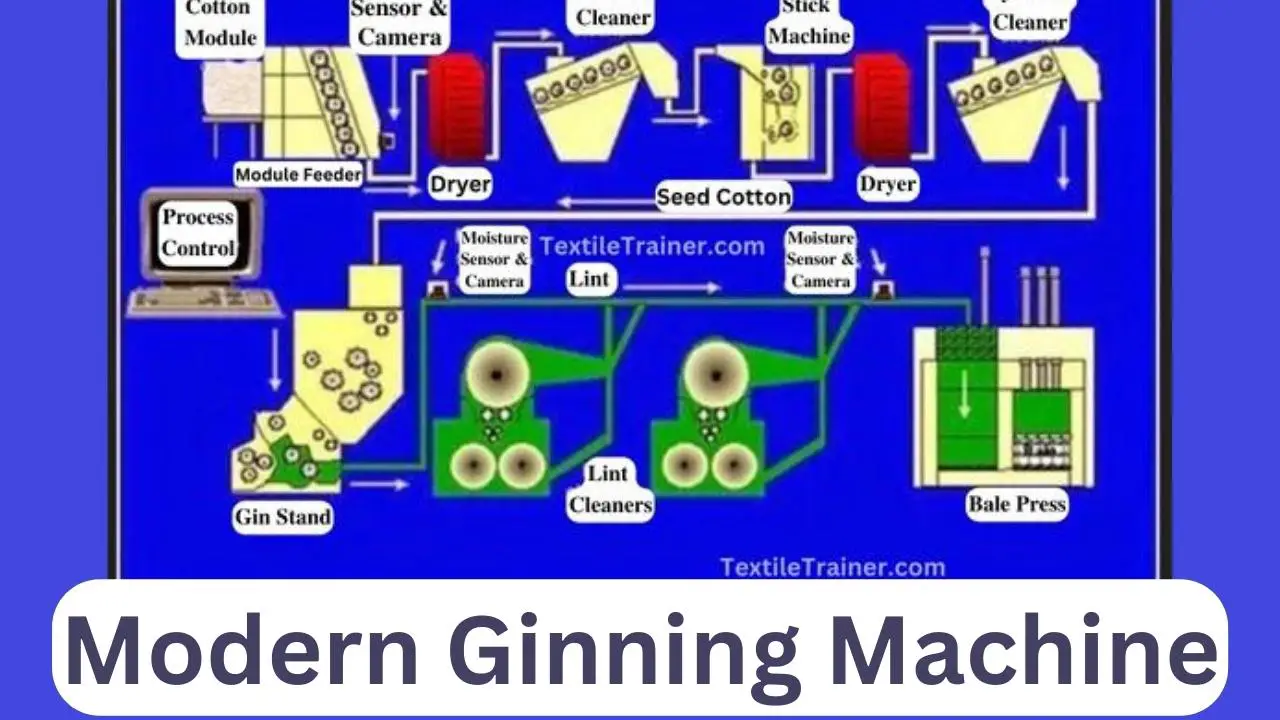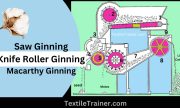Introduction:
Cotton ginning is a machine that separates cotton fibers from seeds quickly and easily, allowing for much higher productivity than manual cotton separation. Fibers are processed into clothing and other cotton goods, and seeds can be used to grow cotton or to produce cottonseed oil and meal. During the spinning process, this step is very important. After harvesting seed cotton, it is transported to nearby gins for lint and seed separation. A typical gin produces 12 bales per hour (1 bale = 500 pounds). Earlier, ginning was done manually, but today manufacturers use automated machines that are more productive to increase production. In the cotton industry, the machine is known as a cotton ginning machine. Different parts of modern ginning machine is described in this article.
Objectives:
- To know about ginning machine.
- To know different part of ginning machine.
- To know working principle of modern ginning machine.
We can simply define ginning as the process of separating or removing seeds, dust or other foreign objects from cotton. The cotton spinning mills will be able to offer better cotton as a result.
Objects of Ginning:
- Ensure that the fiber is free from seeds without being gin-cut.
- Achieve fair market prices for cotton while ensuring the highest quality.
- It is important to be confident that fiber does not contain any surprises or excess seeds.
- For the purpose of simplifying and improving the spinning process.
Modern Ginning Machine:
- In modern cotton production, cotton arrives at cotton gins either in trailers or compressed “modules,” weighing up to 10 metric tons each. A pipe approximately 16 inches (41 cm) in diameter is swung over the cotton when it arrives in trailers and draws into the gin. The pipe is generally operated manually but is increasingly automated in today’s cotton plants.
- After the module was introduced, trailers did not need to haul the product to the gin. The module feeder separates the modules using spiked rollers and removes the largest foreign materials from the cotton if shipped in modules. A module feeder’s loose cotton is then sucked into the same starting point as trailer cotton.
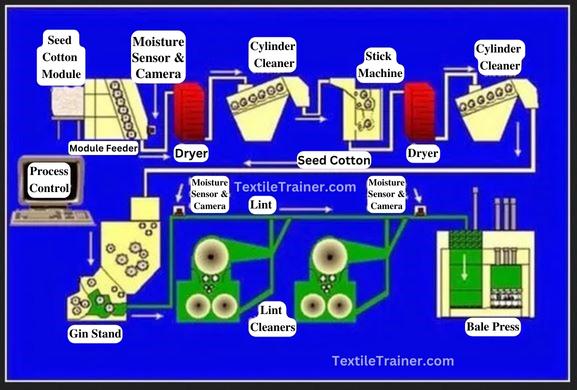
Different parts of Description of each cotton ginning machine is given below:
1. Feeder:
- A stationary head feeder breaks apart modules with spiked rollers. In order to transport the modules to the stationary dispersing head, flat wire-mesh belts or chains similar to those used by module trucks are used to construct the beds.
- There is a minimum requirement of 1-1/2 beds, but additional beds can be added to increase ginning time. The stationary dispersing head features horizontal spiked cylinders that separate cotton from the module’s face and deposit it in an airline or on a conveyor for conveyance to the gin mechanically or pneumatically.
2. Dryer:
- In the first stage of drying, heated air is used to convey the cotton through the shelves for 10-15 seconds. Temperature-controlled conveying air is used to control drying.
- In order to prevent fiber damage, cotton should never be exposed to temperatures above 350 F during normal operation. Cotton fibers can undergo permanent physical changes at temperatures above 300 F. Temperature sensors in dryers should be placed as close to the point at which cotton is heated and mixed with heated air as possible.
- When the temperature sensor is located near the exit of the tower dryer, the mixpoint temperature may be 100-200 degrees higher than that measured downstream. Due to evaporation and heat loss through machinery and pipes, the temperature drops downstream.
3. Cylinder Cleaner:
- Warm air continues to dry the seed cotton as it is moved to the cylinder cleaner, which consists of six or seven revolving spiked cylinders rotating at 400 to 500 rotations per minute.
- A series of grid rods or screens agitates the cotton, and the openings allow fine foreign materials, such as leaves, trash, and dirt, to pass through for disposal. Cylinder cleaners break up large wads and condition cotton for additional cleaning and drying. The processing rate for cylinders is 2 bales per foot per hour.
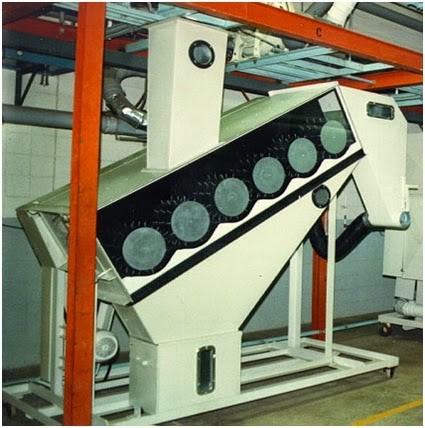
4. Stick Machine:
Stick machines remove larger foreign objects from cotton, such as burs and sticks. The stick machine uses the centrifugal force created by rotating saw cylinders at 300-400 rpm to sling off foreign material while holding the fiber. The reclaimed spits out foreign matter, which feeds the trash disposal system. The processing rate of 1.5-2.0 bales/hr/ft of cylinder length is typical.
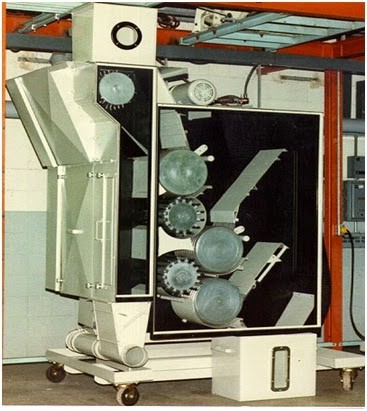
5. Extractor Feeder:
Its primary function is to feed seed cotton to the gin stand uniformly at controlled rates, while extracting and cleaning is its secondary function. In the feeder, two star-shaped feed rollers located directly under the distributor hopper control the seed cotton’s feed rate.
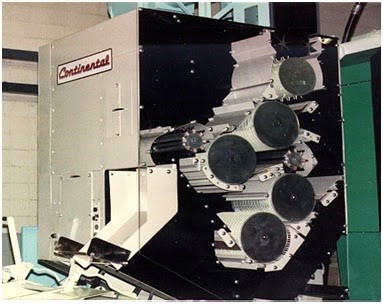
6. Gin Stand:
- A modern gin plant typically has multiple gin stands. The cotton enters the gin stand through a huller front. Cotton is grasped and drawn through widely spaced ribs called huller ribs by the saws. During the rolling process, the cotton locks are drawn from the huller ribs and put into the roll box at the bottom.
- The actual ginning process–separating lint from seed–takes place in the roll box of the gin stand. Ginning is accomplished by rotating saws between ginning ribs. When the saw teeth are at the ginning point, they are passed between the ribs. In this instance, the teeth are placed approximately parallel to the rib, and the teeth pull the fibers from the seed, which are too large to pass between the ribs.
- The process of ginning at rates that exceed the manufacturer’s recommendation can result in fiber quality reduction, seed damage, and chokeups. There are also important considerations when it comes to gin stand saw speeds. As a result of high speeds, fiber damage is more likely to occur during ginning.
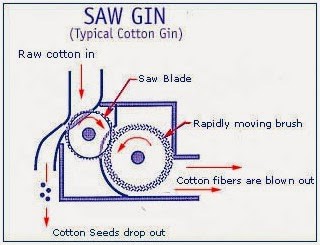
7. Lint Cleaner:
- The flow of cotton should be uniform and well dispersed as it leaves the gin stand. The cotton is conveyed to the condensers through lint ducts from the gin stand. It is then formed back into a batt.
- Batts are removed from condenser drums and fed into saw-type lint cleaners. The batt should be uniformly thick and evenly spread over the entire width of the lint cleaner to prevent poor cleaning and excessive fiber loss.
8. Bale Press:
- Clean cotton is compressed into bales, which are then covered to prevent contamination during transportation and storage. There are three types of bales produced: modified flat, compress universal density, and gin universal density. A modified flat bale weighs 14 pounds per square foot, while a universal density bale weighs 28 pounds per square foot.
- In most gins cotton is packaged in a “double-box” press in which the lint is initially compacted in one press box by a mechanical or hydraulic tramper; after the press box is rotated, the lint is further compressed by a modified flat or gin universal density press to about 20 or 40 lb/ft3, respectively. Optimal freight rates can be achieved by recompressing modified flat bales into compressed universal density bales later on.
- Approximately 96 percent of the bales in the United States were gin universal density bales in 1996. It is recommended that bales should only be packaged and tied in material approved by the Commodity Credit Corporation for storage.
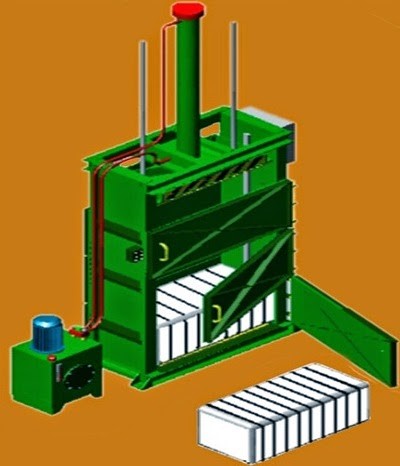
Conclusion:
Basically, ginning is the process of removing seeds, dust, or other foreign particles from cotton to get the cleaned cotton. So that cotton spinning mills can receive better cotton. This experiment taught us about the working principle of a modern ginning machine. We will be able to use that information in the future.
